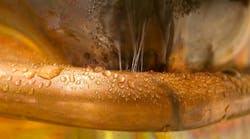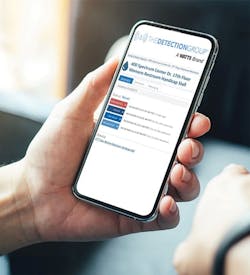Latest from Best Practices
Sponsored
The last thing a contractor and engineer needs is to be contacted by the facility owner of their last project, notifying them that they are responsible for damages caused by a water leak. Yet, that is a possibility since contractors and engineers are liable for such leaks up to a year after project completion. Integrating an intelligent water management system from day one can help this scenario be significantly less probable—and much less expensive if it does occur.
While preventing any water damage is the ultimate goal, a more realistic scenario is to minimize the effects of a leak when it does occur. The reason is that over 300 leaks occur in US commercial buildings per day, and many go unnoticed until they cause significant damage. Because of this, the best solution is to be proactive and equip buildings with advanced technology that can detect leaks within minutes to save buildings from dangerous and costly damage.
Wired and Wireless Systems
Contractors and engineers have a choice of wired or wireless leak detection systems. For new constructions, it can be less complicated to implement wired systems, as they can be integrated into the planning process at the onset of a project. The equipment can be properly installed in high-risk areas as part of the overall build. However, running hundreds of feet of wire stll increases the potential for error. This process can also be time-consuming, which can lead to delays in construction schedules.
For these reasons, wireless systems that utilize sensors and the cloud to provide remote information 24/7/365 is a more efficient approach (figure 1). Along with the added convenience and simplicity, these systems are more discreet than traditional wired alternatives, allowing them to provide complete coverage without interfering with day-to-day operations.
Even after selecting a wireless system, engineers and contractors must decide between RF or Wi-Fi transmission. There are multiple reasons that systems that communicate via RF are more advantageous specifically for commercial buildings:
- Range – RF can extend to entire buildings; Wi-Fi does not have similar range, so it may not be able to reach certain sensors depending on their location.
- More Reliable Coverage – RF signals are also able to penetrate dense building materials that may thwart W-Fi communication. Wi-Fi-enabled systems can also be more prone to coverage drops or security concerns.
- Power – Systems that communicate via Wi-Fi also draw more power for daily operation. Whereas RF-enabled systems transmit only when sending an alert, Wi-Fi systems use more power to stay connected. Operators may have to charge and replace batteries more frequently with Wi-Fi systems. Along with associated costs, there is also the risk of a system not having enough power to function properly.
Up Front Investment Reduces Future Costs
When assessing a building’s need for leak detection technology, the system’s price will obviously be a factor in the decision. However, the costs that will be minimized by robust leak detection technologies should also be taken into the equation to determine the actual lifetime value and return on investment (ROI).
When it comes to water damage, the aftermath is rarely a simple fix. When considering not only that most insurance claims in commercial buildings relate to water damage, but also that the average cost of water damage claims in commercial real estate can reach up to $100,000, the expenses can easily add up from one leak alone. Additionally, insurance premiums may also increase due to a reported leak. This bill can get even larger if mold forms from the moisture, as professional removal and remediation can cost, on average, $10 to $30 per square foot.
Water leaks often impact revenue, as well. In a manufacturing setting, a leak will often cause a work stoppage in everyday activities and potential damage to important machinery, driving further costs due to lost business. In apartment and office buildings a serious water leak may lead to occupants having to work in other locations. Such a scenario will result in landlords providing rebates or being responsible for paying for those secondary locations.
For all these reasons, all it takes is one leak prevented for the system to pay for itself. It makes for a strong selling point for contractors and engineers when presenting the cost of a system to facility owners.
Saving Wasted Water
Another advantage of leak detection systems that contractors and engineers can explain to building owners is lower water bills. According to the EPA’s WaterSense program, leaks are responsible for more than 6 percent of a facility’s total water use on average.
Real-time leak detection technology allows plumbing engineers and other commercial building personnel to receive immediate notifications that can alert them of a problem with a system (figure 2). This allows remediation efforts to be initiated quickly in response to an issue, for faster resolution. Whether it’s a leak or any other inefficiency, detecting the problem early equates to more economical water bills.
Water Damage Hurts Structural Integrity
Wood, drywall and other similar materials can grow weaker when exposed to large amounts of water. Waterlogged building materials can also warp and sag, which can have a significant impact on overall structural integrity. Repairing and replacing these materials is costly and time-consuming. Additionally, prolonged exposure to water carries the risk of collapse, especially if moisture seeps into the building’s foundation.
Compounding this issue is that such leaks are typically out of sight and difficult to monitor. By the time water damage is visible, it typically means costly remediation is necessary.
Thankfully, modern technology can continuously track plumbing systems, pumps, appliances and other water sources to identify issues that can indicate a leak. These leak detection systems can also alert engineers and other building personnel, who can take the necessary steps to fix the issue and minimize any structural damage. Advanced systems also have automatic shut-off features, further reducing the amount of damage caused.
Conclusion
Whether it’s new construction or a retrofit, engineers and contractors should install modern leak detection systems to protect commercial buildings. While completely preventing leaks and the associated water damage isn’t a realistic strategy, investing in the right technology can create long-term savings by identifying issues before they become severe. Furthermore, wireless technologies offer a more efficient approach by eliminating the time-consuming installation process associated with traditional wired systems.
Curtis Wondra
Curtis Wondra has managed sales teams and customer relationships for over 16 years while designing various water and steam systems for HVAC and industrial processes. He manages the direct sales efforts for The Detection Group. Prior, he worked for two manufacturer’s representatives, managing a sales portfolio of 40+ manufacturers and suppliers. Before his HVAC and industrial experience, Wondra was a design engineer for Cessna. He holds a BS in Mechanical Engineering from Wichita State University.




